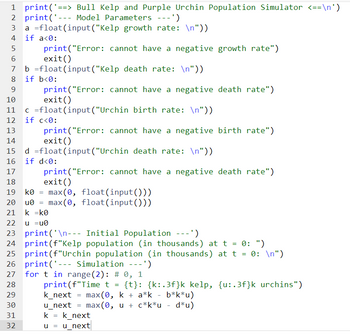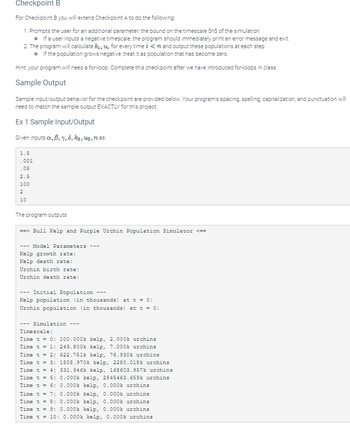
Database System Concepts
7th Edition
ISBN: 9780078022159
Author: Abraham Silberschatz Professor, Henry F. Korth, S. Sudarshan
Publisher: McGraw-Hill Education
expand_more
expand_more
format_list_bulleted
Question
how to do i solve this question while using this python code

Transcribed Image Text:1 print('==> Bull Kelp and Purple Urchin Population Simulator <==\n')
2 print('- Model Parameters ---')
4
5
6
9
print("Error:
exit()
b =float (input("Kelp death rate: \n"))
8 if b<0:
10
16
17
18
19
---
a float (input("Kelp growth rate: \n"))
if a<0:
29
30
31
32
11 c =float
12 if c<0:
13
14
print("Error:
exit()
=
(input("Urchin birth rate: \n"))
print("Error: cannot have a negative birth rate")
exit()
d =float (input("Urchin death rate: \n"))
if d<0:
cannot have a negative growth rate")
print("Error: cannot have a negative death rate")
exit()
k0 max(0, float(input()))
20 u0= max(0, float(input()))
21 k =k0
22 u =u0
23 print('\n--- Initial Population ---')
24 print (f"Kelp population (in thousands) at t = 0: ")
25 print (f"Urchin population (in thousands) at t = 0: \n")
26 print('- Simulation ---')
27
28
cannot have a negative death rate")
=
for t in range (2): # 0, 1
print (f"Time t = {t}: {k:.3f}k kelp, {u:.3f}k urchins")
k_next max(0, k + a*k - b*k*u)
u_next = max(0, u + c*k*u d*u)
k k_next
u =
u_next

Transcribed Image Text:Checkpoint B
For Checkpoint B you will extend Checkpoint A to do the following:
1. Prompts the user for an additional parameter: the bound on the timescale $n$ of the simulation
• If a user inputs a negative timescale, the program should immediately print an error message and exit.
2. The program will calculate ki, u for every time in and output these populations at each step
• If the population grows negative, treat it as population that has become zero.
Hint: your program will need a for-loop. Complete this checkpoint after we have introduced for-loops in class.
Sample Output
Sample input/output behavior for the checkpoint are provided below. Your program's spacing, spelling, capitalization, and punctuation will
need to match the sample output EXACTLY for this project.
Ex 1 Sample Input/Output
Given inputs a, 6, 7, 8, ko, ug, nas:
1.5
.001
.05
2.5
100
2
10
The program outputs
==>Bull Kelp and Purple Urchin Population Simulator <==
- Model Parameters
Kelp growth rate:
Kelp death rate:
Urchin birth rate:
Urchin death rate:
Initial Population
Kelp population (in thousands) at t = 0:
Urchin population (in thousands) at t = 0:
--- Simulation
---
Timescale:
Time t = 0: 100.000k kelp, 2.000k urchins
249.800k kelp, 7.000k urchins
Time t = 1:
Time t = 2:
622.751k kelp, 76.930k urchins
Time t = 3: 1508.970k kelp, 2280.018k urchins
Time t = 4: 331.946k kelp, 168603.957k urchins
Time t = 5: 0.000k kelp, 2545463.659k urchins
Time t = 6: 0.000k kelp, 0.000k urchins
Time t = 7:
Time t = 8:
Time t = 9: 0.000k kelp, 0.000k urchins
Time t = 10: 0.000k kelp, 0.000k urchins
0.000k kelp, 0.000k urchins
0.000k kelp, 0.000k urchins
Expert Solution
arrow_forward
Step 1
Introduction
Library:
Python has a vast number of libraries that can be used for various purposes, such as scientific computing, data analysis, web development, machine learning, and more. Here are a few examples of popular Python libraries:
Numpy, Pandas, math etc.
Trending nowThis is a popular solution!
Step by stepSolved in 4 steps with 3 images

Knowledge Booster
Learn more about
Need a deep-dive on the concept behind this application? Look no further. Learn more about this topic, computer-science and related others by exploring similar questions and additional content below.Similar questions
- How can I print the last two digits of a whole number in python?arrow_forwardHow can I print the address and value of an variable in python.arrow_forwardcan you show me how to answer this on sypder using python as a calculator (zellers congruence) 1(i) On what day of the week is Yorkshire Day next year (1st August 2024)? (ii) Charles Babbage was born on 26 December 1791. What day of the week was that?arrow_forward
- Add a main function to the following python code and organize the program using mainline logic. def resistance(i,e): return e/i #Compute the total resistance as per the given formula def parallel_resistance(r1,r2,r3): return 1.0/((1.0/r1)+(1.0/r2)+(1.0/r3)) #Compute the series resistance def series_resistance(r1,r2,r3): return r1+r2+r3 #Read the voltage e1=float(input('Voltage 1 : '))e2=float(input('Voltage 2 : '))e3=float(input('Voltage 3 : ')) #Read the currenti1=float(input('Current 1 : '))i2=float(input('Current 2 : '))i3=float(input('Current 3 : ')) #Compute the resistance r1=resistance(i1,e1)r2=resistance(i2,e2)r3=resistance(i3,e3) #Compute the resistance in parallel Circuitrp=parallel_resistance(r1,r2,r3) #Compute the resistance in series Circuitrs=series_resistance(r1,r2,r3) #Display the result print('Resistance in Parallel Circuit : {0:.2f}'.format(rp))print('Resistance in Series Circuit : {0:.2f}'.format(rs))arrow_forwardPLEASE MATLAB NOT PYTHON OR OTHERSarrow_forwardPlease give some examples on how to use the following in Python. Please do example codes Bool, int, floats Range List slicing operationsarrow_forward
arrow_back_ios
arrow_forward_ios
Recommended textbooks for you
 Database System ConceptsComputer ScienceISBN:9780078022159Author:Abraham Silberschatz Professor, Henry F. Korth, S. SudarshanPublisher:McGraw-Hill Education
Database System ConceptsComputer ScienceISBN:9780078022159Author:Abraham Silberschatz Professor, Henry F. Korth, S. SudarshanPublisher:McGraw-Hill Education Starting Out with Python (4th Edition)Computer ScienceISBN:9780134444321Author:Tony GaddisPublisher:PEARSON
Starting Out with Python (4th Edition)Computer ScienceISBN:9780134444321Author:Tony GaddisPublisher:PEARSON Digital Fundamentals (11th Edition)Computer ScienceISBN:9780132737968Author:Thomas L. FloydPublisher:PEARSON
Digital Fundamentals (11th Edition)Computer ScienceISBN:9780132737968Author:Thomas L. FloydPublisher:PEARSON C How to Program (8th Edition)Computer ScienceISBN:9780133976892Author:Paul J. Deitel, Harvey DeitelPublisher:PEARSON
C How to Program (8th Edition)Computer ScienceISBN:9780133976892Author:Paul J. Deitel, Harvey DeitelPublisher:PEARSON Database Systems: Design, Implementation, & Manag...Computer ScienceISBN:9781337627900Author:Carlos Coronel, Steven MorrisPublisher:Cengage Learning
Database Systems: Design, Implementation, & Manag...Computer ScienceISBN:9781337627900Author:Carlos Coronel, Steven MorrisPublisher:Cengage Learning Programmable Logic ControllersComputer ScienceISBN:9780073373843Author:Frank D. PetruzellaPublisher:McGraw-Hill Education
Programmable Logic ControllersComputer ScienceISBN:9780073373843Author:Frank D. PetruzellaPublisher:McGraw-Hill Education

Database System Concepts
Computer Science
ISBN:9780078022159
Author:Abraham Silberschatz Professor, Henry F. Korth, S. Sudarshan
Publisher:McGraw-Hill Education

Starting Out with Python (4th Edition)
Computer Science
ISBN:9780134444321
Author:Tony Gaddis
Publisher:PEARSON

Digital Fundamentals (11th Edition)
Computer Science
ISBN:9780132737968
Author:Thomas L. Floyd
Publisher:PEARSON

C How to Program (8th Edition)
Computer Science
ISBN:9780133976892
Author:Paul J. Deitel, Harvey Deitel
Publisher:PEARSON

Database Systems: Design, Implementation, & Manag...
Computer Science
ISBN:9781337627900
Author:Carlos Coronel, Steven Morris
Publisher:Cengage Learning

Programmable Logic Controllers
Computer Science
ISBN:9780073373843
Author:Frank D. Petruzella
Publisher:McGraw-Hill Education